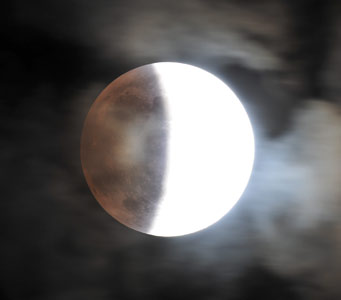Watch the full Moon become partly engulfed by Earth's shadow during a partial lunar eclipse on June 4th.

Earth’s round shadow will extend 38% of the way across the Moon at maximum eclipse on June 4, 2012, fairly similar to how the Moon looked when Dennis di Cicco shot this image during the eclipse of February 20–21, 2008. He overexposed the Moon’s sunlit part to bring out the ruddy color of Earth’s umbra.
S&T: Dennis di Cicco
On the morning of Monday, June 4, 2012 — the day before the transit of Venus (by pure coincidence) — skywatchers in much of the Americas, the Pacific, Australia, and East Asia will witness some very different blackout action, as the full Moon undergoes a partial eclipse.
The celestial southeastern rim of the Moon first touches the umbra (dark central part) of Earth’s shadow at 10:00 Universal Time. That’s 6:00 a.m. Eastern Daylight Time, 5:00 CDT, 4:00 MDT, and 3:00 PDT.
By that time the Moon has already set and the Sun risen for the northeastern U.S. and Canada; people there miss out. If you're west of a line from North Carolina through Ohio, you get to see at least the eclipse’s beginning as the Moon is about to set and the Sun is about to rise. Here's a world map and eclipse diagram showing who gets to see what.
The partial eclipse is deepest, with the umbra intruding 38% of the way across the Moon from the south, more than an hour later, at 11:03 UT. By then you’ll need to be west of a line from Louisiana through North Dakota.
The partial eclipse ends at 12:07 UT. Far Westerners see the whole event high in a dark sky before dawn gets under way.
The penumbra (pale outer fringe) of Earth’s shadow should be visible on the Moon as much as 45 minutes before the partial phase starts and after it ends.
 0
0









Comments
You must be logged in to post a comment.